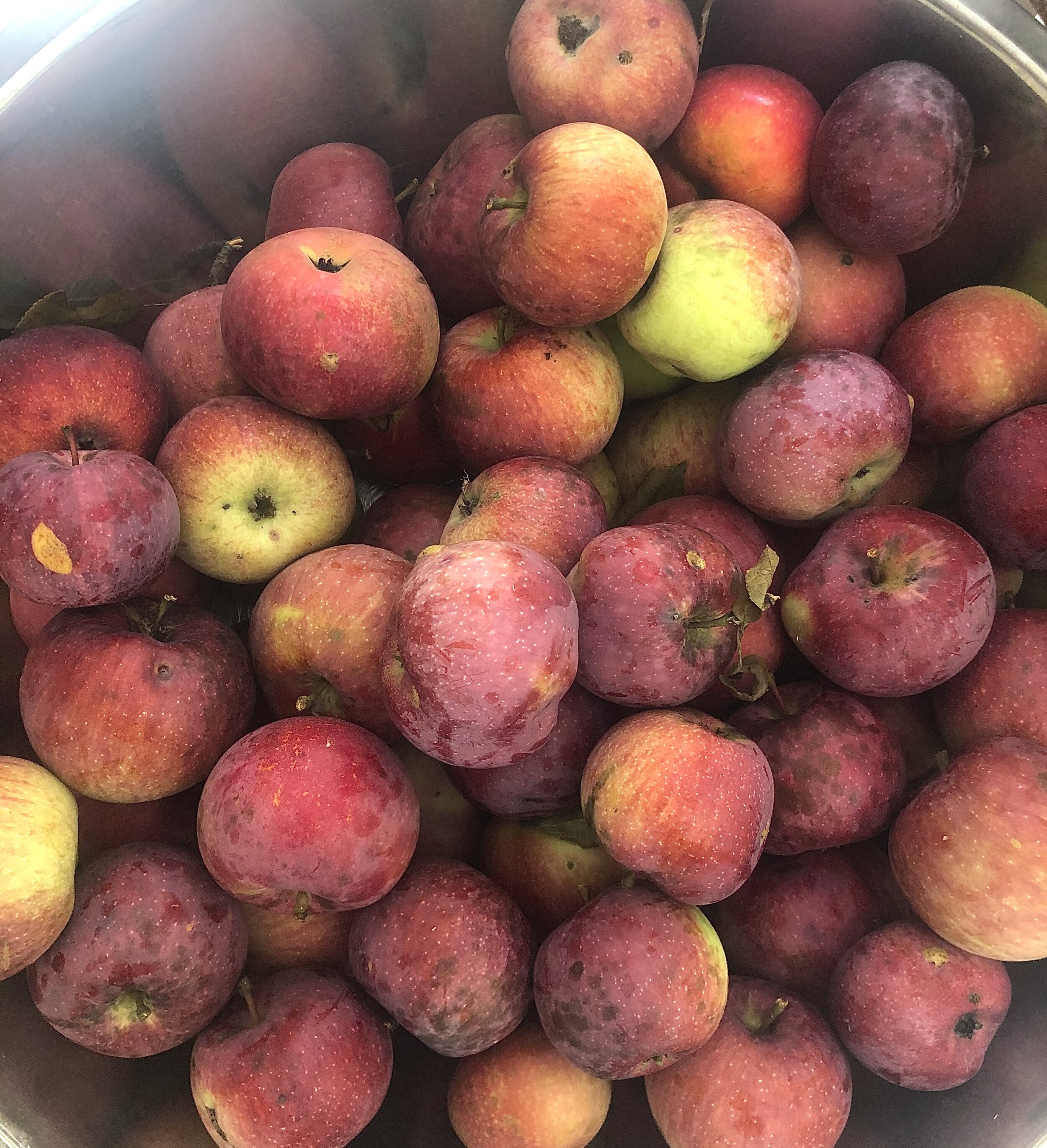On a sunny Saturday morning Carrie invited me into the kitchen to learn how to make a version of Halwa inspired by apples collected from her neighbor’s abandoned orchard.
My first task was to peel the skin from the apples. A seemingly simple technique was harder than expected and I fiddled around with different knives until I figured out the placement to remove the peel in a swift spiral. All the discarded scraps of apples were importantly saved for jelly making. It seems any discarded or unwanted ingredient can be fashioned into a new creation at Atina Foods. After working my way through the bowl of apples, we put the flesh into a food processor with some coconut milk, and blended until smooth. While I oversaw the blending process, Carrie melted a knob of ghee and began to sauté a mix of cashews and dried blueberries. She mentioned golden raisins are also a delicious alternative.
The toasted nuts and pureed apple started to fill the kitchen with a sweet, warming aroma, soon to be enhanced by freshly ground cardamom. The nuts were set aside and a larger knob of ghee was added to the pot. Once hot, the apple pulp was gently scooped in, and immediately the stirring began to avoid any residue sticking and burning. Given the large portion we were preparing, there were two active pots, at one point I was stirring both at once in a synchronized x shaped motion. A good arm workout!
This process took around 20 minutes, the texture slowly transforming and color darkening as we incorporated the sugar, cardamom, cashews, blueberries and Atina’s Rhubarb Ginger Herbal Jam. A dash of vanilla was also added for balance. Carrie emphasized the importance of balance, especially in Ayurvedic cooking which incorporates six tastes (sweet, sour, salty, pungent, bitter and astringent). Adjusting the flavor profile of the Halwa required an attentive pallet to recognize when a specific ingredient needed to be accentuated or toned down. Carrie laughed saying her husband Suresh is such a masterful alchemist in the kitchen, he doesn’t even need a taste test to achieve a balanced flavor.
Once a thick, fudge like consistency emerged from the liquid’s evaporation, it was time to scoop the Halwa into dishes for serving! I was surprised by the subtle yet intricate the flavors—the apple and rhubarb create a sweet tartness complemented by the warming, nutty ghee, cashews and cardamom.
When Suresh returned from a day at the market, he recalled some stories about the origins of Halwa. ‘Halwa’ originates from the Arabic word for sweet, ‘hulw.’ It is usually a simple, condensed combination of starch, fat and sweetener, (with or without a fruit or vegetable), some using a nut base, dried fruit, spices or other ingredients to add aromatics. The treat is believed to have arrived in India from the Middle East through Indo-Roman trade routes. Suresh explained that merchants and seamen traveling the Indo Roman trade route from Sinai to Kerala, South India, via the Nile river and Arabian Sea, needed shelf stable food that would last for months. Referred to as “sweet meat,” Halwa accompanied these sailors on long voyages, picking up new influences as it traveled through different continents. A town in Kozhikode, Kerala, famous for it’s fruit Halwa, even has a “Sweet Meat’ street named after it! The sweet continues to evolve today… here, using local Catskill apples! A customer at the market, that same day, declared you can “taste the history” in Atina’s products. To make Atina’s Apple Rhubarb Ginger Halwa yourself, find the recipe we made below!
- Olivia Miller, onlygoodsimple.com
Ingredients
(No need to be exact, find a balance of sweet and tart)
Apples, 3 big or equal that in other sizes
Milk of choice, I use coconut or almond – 1/3 cup
Sugar – 1 to 1 1/2 half cups
Ghee – 3 to 4 tablespoons (coconut oil is also good)
Cardamom Powder – 1/2 tsp
Cashew nuts or almonds – baby hand full
Dried fruit of choice, like golden raisins or blueberries
Atina Food's Rhubarb Ginger Herbal Jam – 1 tablespoon
Directions
Clean the apples with water, peel and core them— save your scraps for vinegar!
Put the flesh and milk into a food processor and blend until the consistency is similar to apple sauce or even finer. The more liquid you add to blend, the longer it will take to cook down later.
In a thick bottomed pot, wok or kadai (preferably stainless non-stick, not aluminum) add one teaspoon of ghee and fry the nuts and dried fruit. Let the fruit plump up in the oil. Remove from the pan and set aside.
Add the remaining tablespoons of ghee and once melted, add in the apple pulp.
Fry on medium heat until the water content in the pulp is evaporated and the pulp becomes slightly thick. Stir constantly as water begins to evaporate (20 -30 minutes).
Add sugar to the pulp and mix well. Stir continuously.
Add the cardamom powder (we freshly Mortar and Pestle the seed pod and remove skin when done).
Add the fried cashew fruit mix and a spoonful of Atina Food's Rhubarb Ginger Herbal Jam.
Mix everything well and transfer it into a greased bowl, parchment lined casserole dish, or even a muffin tray.
While it can be eaten warm, it is best served cool. Refrigerate for 15-30 minutes to let it set and cool. Serve with a spoon or cut it into squares, there should be around 15 pieces. Enjoy!







